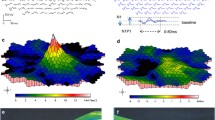Abstract
Purpose
We aimed to analyze the electrophysiologic function and morphology of macula in vitiligo patients.
Methods
Seventeen patients with vitiligo and 11 healthy subjects were studied. All participants underwent multifocal electroretinography (mfERG) and spectral domain optical coherence tomography (SD-OCT) evaluations. The mfERG (P1 mfERG responses central and peripheral) and retinal layer segmentation parameters (nine ETDRS subfields) were compared in vitiligo and control groups.
Results
The mean P1 response amplitudes were significantly decreased in central and peripheral rings of the fovea in patients with vitiligo compared with controls (p = 0.002 and p = 0.006, respectively). There was a tendency toward a prolonged mean implicit time for both central and peripheral in patients with vitiligo compared to controls, however, with no statistical significance (p = 0.453 and p = 0.05, respectively). There was no statistically significant difference in all retinal layers thickness between two groups.
Conclusion
In patients with vitiligo, while photoreceptor segment preserved in SD-OCT, mfERG reduced showing potential decline in central retinal function. This study showed a potential decline in central retinal function in patients with vitiligo even if they have normal fundus appearance and SD-OCT findings.



Similar content being viewed by others
References
Ezzedine K, Lim HW, Suzuki T, Katayama I, Hamzavi I, Lan CCE et al (2012) Revised classification/nomenclature of vitiligo and related issues: the Vitiligo Global Issues Consensus Conference. Pigment Cell Melanoma Res 25:E1–E13
Karadag R, Esmer O, Karadag AS, Bilgili SG, Cakici O, Demircan YT et al (2016) Evaluation of ocular findings in patients with vitiligo. Int J Dermatol 55:351–355
Biswas G, Barbhuiya JN, Biswas MC, Islam MN, Dutta S (2003) Clinical pattern of ocular manifestations in vitiligo. J Indian Med Assoc 101:478–480
Bulbul Baskan E, Baykara M, Ercan I, Tunali S, Yucel A (2006) Vitiligo and ocular findings: a study on possibleassociations. J Eur Acad Dermatol Venereol 20:829–833
Shoeibi N, Taheri AR, Nikandish M, Omidtabrizi A, Khosravi N (2014) Electrophysiologic evaluation of retinal function in patients with psoriasis and vitiligo. Doc Ophthalmol 128:131–136
Tang M, Pawlyk BS, Kosaras B, Berson EL, Sidman RL (1997) ERG abnormalities in relation to histopathologic findings in vitiligo mutant mice. Exp Eye Res 65:215–222
Perossini M, Turio E, Perossini T, Cei G, Barachini P (2010) Vitiligo: ocular and electrophysiological findings. G Ital Dermatol Venereol 145:141–149
Albert DM, Wagoner MD, Pruett RC, Nordlund JJ, Lerner AB (1983) Vitiligo and disorders of the retinal pigment epithelium. Br J Ophthalmol 67:153–156
Sutter EE, Tran D (1992) The field topography of ERG components in man—I. The photopic luminance response. Vis Res 32:433–446
Bearse MA, Sutter EE (1996) Imaging localized retinal dysfunction with the multifocal electroretinogram. J Opt Soc Am A 13:634–640
Horio N, Kachi S, Hori K, Okamoto Y, Yamamoto E, Terasaki H et al (2001) Progressive change of optical coherence tomography scans in retinal degeneration slow mice. Arch Ophthalmol 119:1329–1332
Bora N, Defoe D, Smith SB (1999) Evidence of decreased adhesion between the neural retina and retinal pigmented epithelium of the Mitfvit (vitiligo) mutant mouse. Cell Tissue Res 295:65–75
Hood DC, Lin CE, Lazow MA, Locke KG, Zhang X, Birch DG (2009) Thickness of receptor and post-receptor retinal layers in patients with retinitis pigmentosa measured with frequency-domain optical coherence tomography. Invest Ophthalmol Vis Sci 50:2328–2336
Witkin AJ, Ko TH, Fujimoto JG, Chan A, Drexler W, Schuman JS et al (2006) Ultra-high resolution optical coherence tomography assessment of photoreceptors in retinitis pigmentosa and related diseases. Am J Ophthalmol 142:945–952
Menghini M, Lujan BJ, Zayit-Soudry S, Reema Syed R, Porco TC, Bayabo K et al (2015) Correlation of outer nuclear layer thickness with cone density values in patients with retinitis pigmentosa and healthy subjects. Invest Ophthalmol Vis Sci 56:372–381
Hood DC, Bach M, Brigell M, Keating D, Kondo M, Lyons JS, International Society For Clinical Electrophysiology of Vision et al (2012) ISCEV standard for clinical multifocal electroretinography (mfERG) (2011 edition). Doc Ophthalmol 124:1–13
Smith SB, Bora N, McCool D, Kutty G, Wong P, Kutty RK et al (1995) Photoreceptor cells in the vitiligo mouse die by apoptosis. TRPM-2/cluster in expression is increased in the neural retina and in the retinal pigment epithelium. Invest Ophthalmol Vis Sci. 36:2193–2201
Milam AH, Li ZY, Fariss RN (1998) Histopathology of the human retina in retinitis pigmentosa. Prog Retin Eye Res 17:175–205
Sugita T, Kondo M, Piao CH, Ito Y, Terasaki H (2008) Correlation between macular volume and focal macular electroretinogram in patients with retinitis pigmentosa. Invest Ophthalmol Vis Sci 49:3551–3558
Wolsley CJ, Silvestri G, O’Neill J, Saunders KJ, Anderson RS (2009) The association between multifocal electroretinograms and OCT retinal thickness in retinitis pigmentosa patients with good visual acuity. Eye 23:1524–1531
Funding
No funding was received for this research.
Author information
Authors and Affiliations
Corresponding author
Ethics declarations
Conflict of interest
All authors certify that they have no affiliations with or involvement in any organization or entity with any financial interest or non-financial interest in the subject matter or materials discussed in this manuscript.
Rights and permissions
About this article
Cite this article
Aydin, R., Ozsutcu, M., Erdur, S.K. et al. The assessment of macular electrophysiology and macular morphology in patients with vitiligo. Int Ophthalmol 38, 233–239 (2018). https://doi.org/10.1007/s10792-017-0452-3
Received:
Accepted:
Published:
Issue Date:
DOI: https://doi.org/10.1007/s10792-017-0452-3




